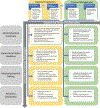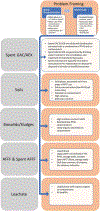Developing innovative treatment technologies for PFAS-containing wastes
- PMID: 34905459
- PMCID: PMC9316338
- DOI: 10.1080/10962247.2021.2000903
Developing innovative treatment technologies for PFAS-containing wastes
Abstract
The release of persistent per- and polyfluoroalkyl substances (PFAS) into the environment is a major concern for the United States Environmental Protection Agency (U.S. EPA). To complement its ongoing research efforts addressing PFAS contamination, the U.S. EPA's Office of Research and Development (ORD) commissioned the PFAS Innovative Treatment Team (PITT) to provide new perspectives on treatment and disposal of high priority PFAS-containing wastes. During its six-month tenure, the team was charged with identifying and developing promising solutions to destroy PFAS. The PITT examined emerging technologies for PFAS waste treatment and selected four technologies for further investigation. These technologies included mechanochemical treatment, electrochemical oxidation, gasification and pyrolysis, and supercritical water oxidation. This paper highlights these four technologies and discusses their prospects and the development needed before potentially becoming available solutions to address PFAS-contaminated waste.Implications: This paper examines four novel, non-combustion technologies or applications for the treatment of persistent per- and polyfluoroalkyl substances (PFAS) wastes. These technologies are introduced to the reader along with their current state of development and areas for further development. This information will be useful for developers, policy makers, and facility managers that are facing increasing issues with disposal of PFAS wastes.
Conflict of interest statement
Disclosure statement
No potential conflict of interest was reported by the author(s).
Figures





References
-
- 374water. 2020. Supercritical Water Oxidation (SCWO) destruction of PFAS contaminated municipal sludge. Accessed 2021. https://www.bluetechforum.com/wp-content/uploads/1.-374Water-BlueTech-Ca...
-
- Abeln J, Kluth M, Petrich G, and Schmieder H. 2001. Supercritical water oxidation (SCWO): A process for the treatment of industrial waste effluents. High Press Res 20 (1– 6):537–47. doi:10.1080/08957950108206202. - DOI
-
- Acheson C, Mills M, Krause M, and Thoma E. 2021. Potential PFAS destruction technology: pyrolysis and gasification. In U.S. EPA Research Briefs. https://www.epa.gov/sites/production/files/2021-01/documents/pitt_resear...
-
- Aro R, Eriksson U, Kärrman A, Chen F, Wang T, and Yeung LW. 2021. Fluorine mass balance analysis of effluent and sludge from Nordic Countries. ACS ES&T Water 1 (9):2087–96. doi:10.1021/acsestwater.1c00168. - DOI
Publication types
MeSH terms
Substances
Grants and funding
LinkOut - more resources
Full Text Sources
Other Literature Sources
Research Materials
